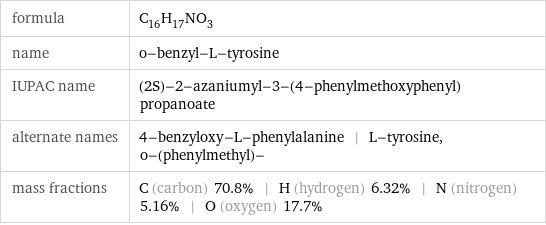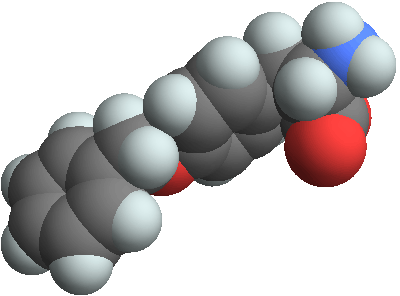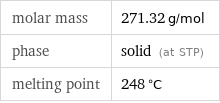Input interpretation

o-benzyl-L-tyrosine
Chemical names and formulas

formula | C_16H_17NO_3 name | o-benzyl-L-tyrosine IUPAC name | (2S)-2-azaniumyl-3-(4-phenylmethoxyphenyl)propanoate alternate names | 4-benzyloxy-L-phenylalanine | L-tyrosine, o-(phenylmethyl)- mass fractions | C (carbon) 70.8% | H (hydrogen) 6.32% | N (nitrogen) 5.16% | O (oxygen) 17.7%
Lewis structure

Draw the Lewis structure of o-benzyl-L-tyrosine. Start by drawing the overall structure of the molecule, ignoring potential double and triple bonds: Count the total valence electrons of the carbon (n_C, val = 4), hydrogen (n_H, val = 1), nitrogen (n_N, val = 5), and oxygen (n_O, val = 6) atoms: 16 n_C, val + 17 n_H, val + n_N, val + 3 n_O, val = 104 Calculate the number of electrons needed to completely fill the valence shells for carbon (n_C, full = 8), hydrogen (n_H, full = 2), nitrogen (n_N, full = 8), and oxygen (n_O, full = 8): 16 n_C, full + 17 n_H, full + n_N, full + 3 n_O, full = 194 Subtracting these two numbers shows that 194 - 104 = 90 bonding electrons are needed. Each bond has two electrons, so in addition to the 38 bonds already present in the diagram add 7 bonds. To minimize formal charge oxygen wants 2 bonds and carbon wants 4 bonds. Identify the atoms that want additional bonds and the number of electrons remaining on each atom: To fully fill its valence shell, nitrogen will donate one of its electrons, allowing it to form four bonds (atoms on period 2 cannot have an expanded valence shell). Fill in the 7 bonds by pairing electrons between adjacent highlighted atoms, noting the formal charges of the atoms. Double bonding carbon to the other highlighted oxygen atom would result in an equivalent molecule. The six atom rings are aromatic, so that the single and double bonds may be rearranged: Answer: | |
3D structure

3D structure
Basic properties

molar mass | 271.32 g/mol phase | solid (at STP) melting point | 248 °C
Units

Chemical identifiers
![CAS number | 16652-64-5 Beilstein number | 2659642 PubChem CID number | 6928217 SMILES identifier | C1=CC=C(C=C1)COC2=CC=C(C=C2)CC(C(=O)[O-])[NH3+] InChI identifier | InChI=1/C16H17NO3/c17-15(16(18)19)10-12-6-8-14(9-7-12)20-11-13-4-2-1-3-5-13/h1-9, 15H, 10-11, 17H2, (H, 18, 19)/t15-/m0/s1/f/h17H EU number | 240-699-1 NSC number | 163630](../image_source/ea6db26ab165c724e5ddf53ff756986f.png)
CAS number | 16652-64-5 Beilstein number | 2659642 PubChem CID number | 6928217 SMILES identifier | C1=CC=C(C=C1)COC2=CC=C(C=C2)CC(C(=O)[O-])[NH3+] InChI identifier | InChI=1/C16H17NO3/c17-15(16(18)19)10-12-6-8-14(9-7-12)20-11-13-4-2-1-3-5-13/h1-9, 15H, 10-11, 17H2, (H, 18, 19)/t15-/m0/s1/f/h17H EU number | 240-699-1 NSC number | 163630
NFPA label

NFPA label

NFPA health rating | 1 NFPA fire rating | 0 NFPA reactivity rating | 0